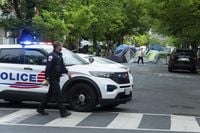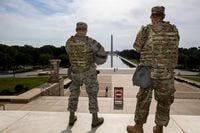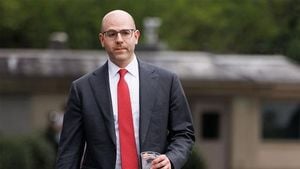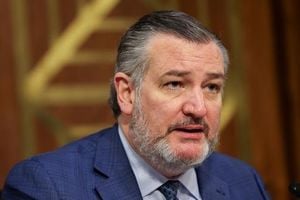In a week marked by legal wrangling, political posturing, and visible shows of force, the Trump administration’s attempt to assert federal control over Washington, D.C.’s police department has ignited fierce debate about the limits of presidential power, the future of the city’s self-governance, and the role of federal law enforcement in local affairs. The saga, playing out in the nation’s capital, has raised fundamental questions about democracy, public safety, and the intersection of politics and policing.
The controversy erupted on August 14, 2025, when President Donald Trump ordered a dramatic increase in the presence of federal law enforcement officers across Washington, D.C., in what the White House described as an effort to “make D.C. safe again.” The move came in the wake of a widely reported assault on a Department of Government Efficiency staffer during an attempted carjacking—a crime that, while concerning, was quickly solved by local police. Despite this, Trump decried what he called “totally out of control” crime in the city and threatened to federalize its police, stating, “We have a capital that’s very unsafe. We have to run D.C.” (as reported by TIME).
Yet, according to data from the city police, violent crime in D.C. was actually down by 26% so far in 2025 compared to the previous year. The U.S. Attorney’s Office for the District of Columbia had noted that 2024 saw total violent crime fall to “the lowest it has been in over 30 years.” These facts did not stop the administration from deploying officers from a suite of federal agencies—including the FBI, DEA, Department of Homeland Security, U.S. Park Police, U.S. Marshals, Immigration and Customs Enforcement, and the Bureau of Alcohol, Tobacco, Firearms and Explosives—across the city, with a particular focus on high-traffic tourist areas (POLITICO and Associated Press).
Escalating the intervention, Attorney General Pam Bondi issued a memo on August 15, 2025, directing the D.C. police to cooperate with federal immigration enforcement “regardless of any city law.” This order came just hours after the administration had named a federal official, Terry Cole of the DEA, as the emergency head of the police department, effectively placing the force under federal control. The city responded swiftly, filing a lawsuit to block what it called an unprecedented federal takeover of local law enforcement.
In a dramatic hearing before U.S. District Judge Ana Reyes, the legal boundaries of the president’s authority were hotly debated. Judge Reyes, nominated by President Joe Biden, indicated that while the law “likely doesn’t grant the Trump administration power to fully take over city police, it probably does give the president more power than the city might like.” She urged both sides to seek a compromise, observing, “The way I read the statute, the president can ask, the mayor must provide, but the president can’t control.” (Associated Press)
The Home Rule Act, passed in 1973, gives D.C. the right to elect its own mayor and council but allows the president some authority over the city, including control of the police for up to 30 days without congressional approval. Trump has suggested he might seek to extend this period, a prospect that alarms many city officials and residents. Notably, he is the first president since the Act’s passage to attempt such a takeover.
Mayor Muriel Bowser, in a letter to D.C. residents, described the week as “unsettling and unprecedented,” pointing to the “waves of anxiety” created by the surge in federal law enforcement. She underscored the city’s limited self-government, writing, “Our limited self-government has never faced the type of test we are facing right now,” but added, “if Washingtonians stick together, we will show the entire nation what it looks like to fight for American democracy—even when we don’t have full access to it.”
The police department, caught in the crossfire, had already eased some restrictions on cooperation with federal officials to facilitate Trump’s mass-deportation campaign, but reaffirmed its commitment to D.C.’s sanctuary city laws. On August 14, Chief Pamela Smith had instructed officers to share information with immigration agencies about people not in custody, such as those involved in traffic stops. Attorney General Bondi, however, found this inadequate, arguing it still allowed “sanctuary policies” to persist.
For immigrant communities, the new directives have sown confusion and fear. Anusce Sanai, associate legal director for the nonprofit Ayuda, told the Associated Press, “Even with the most anti-immigrant administration, we would always tell our clients that they must call the police, that they should call the police. But now we find ourselves that we have to be very careful on what we advise.” Amy Fischer, an organizer with Migrant Solidarity Mutual Aid, described a “really significant change” since the federal takeover, with ICE and federal officers conducting roving patrols and a hotline for reporting ICE activity “receiving calls almost off the hook.”
On the streets, the federal presence has been unmistakable. National Guard troops—150 from Ohio alone, sent by Governor Mike DeWine at the Trump administration’s request—have been stationed at landmarks and federal buildings. DeWine defended his decision, stating, “We don’t care if it’s a Democrat or Republican making the request. We respond to these requests. We will continue to respond.” He emphasized that the Ohio troops, all military police, would play a backup role, focusing on patrol and building protection, and would defer arrests to D.C. police. The initial deployment is set for 30 days but could be extended.
DeWine skirted direct comment on Trump’s claim that D.C. is “the most unsafe city in the United States, and perhaps the world,” noting that murder rates in the capital have actually fallen and that several Ohio cities have higher violent crime rates. His stance drew muted criticism from Dr. Amy Acton, his former health director and a Democratic gubernatorial candidate, who said, “I do have concerns about this being used more as a fearmongering and sort of a political stunt than actually the real needs for our people.”
The deployment of federal officers and National Guard troops has not gone unchallenged. Over the weekend, hundreds of protesters gathered outside the White House and near police headquarters, chanting “Protect home rule!” and waving signs that read “Resist!” Eleanor Holmes Norton, D.C.’s non-voting congressional representative, blasted the federal surge as “a disproportionate overreaction that’s offensive to D.C.,” warning that “this needless escalation will heighten tensions and potentially make D.C., which achieved its lowest violent crime rate in 30 years in 2024, less safe.”
Despite the administration’s claims of a public safety emergency, the facts on the ground tell a more complicated story. While Washington has struggled with spikes in violence and homelessness, its homicide rate remains lower than several other major U.S. cities. For now, the city remains in a state of uneasy limbo—caught between competing visions of governance, law enforcement, and democracy, as the nation watches closely to see how this unprecedented federal intervention will play out.






